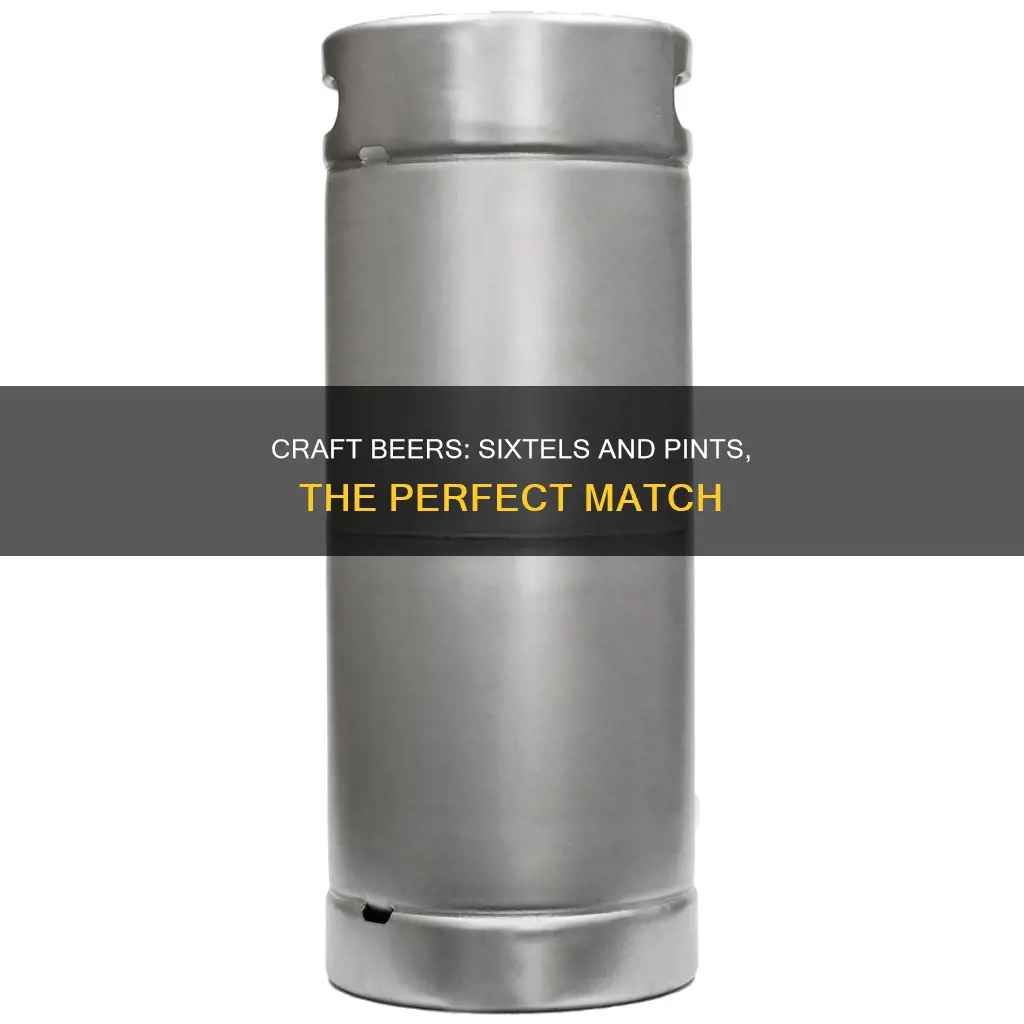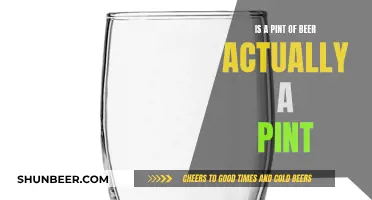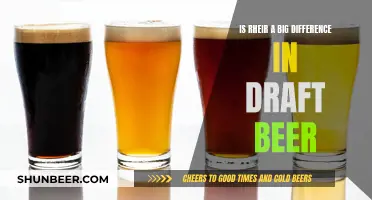
A sixtel, or sixth barrel keg, is a popular option for commercial breweries and restaurants as it takes up less space than a full-size keg. It can hold up to 41 16-ounce pints of beer, which is around 55 12-ounce cans or bottles. This works out to be about 5.16 gallons or 20 litres.
| Characteristics | Values |
|---|---|
| Alternate Names | Sixtel, 1/6 Barrel, 1/6 BBL |
| Capacity | 5.16 gallons / 20 liters / 661 ounces |
| Pints of beer per keg | Approx. 41 |
| Cans / Bottles (12oz) per keg | Approx. 55 |
| Dimensions | 23⅜" x 9¼" |
What You'll Learn

Sixtels hold up to 41 pints of beer
When it comes to storing and serving beer, there are several options to choose from, including half-barrel kegs, sixtels, quarter barrels, 50-litre kegs, and more. Each of these options has different capacities and serves different purposes.
Sixtels, also known as Sixth Barrel Kegs or 1/6 barrels, are popular in commercial breweries due to their traditional keg valve that requires a keg coupler for dispensing. They are slightly bigger than Corny kegs and hold up to 41 pints of beer, or 55 cans/bottles of 12 oz each. This amounts to a capacity of 5.16 gallons or 20 litres.
Bars and restaurants favour sixtels because of their slim design, which makes them easier to store. This means they can order a variety of smaller sixtels and offer their customers a wider range of beers. For example, a bar could use a sixtel for a special, more limited beer such as a seasonal or speciality brew, while opting for a half barrel for a beer that sells consistently.
Sixtels are also a good option for breweries, but less so for high-volume operations. In such cases, a standard half barrel might be a better choice as it holds 124 pints, more than twice the amount of a sixtel.
In summary, sixtels are a convenient option for establishments that want to save space and offer a variety of beers to their customers. With a capacity of up to 41 pints, they provide a good balance between size and variety.
Beer Mug Sizes: Pint Glasses and Their Capacities
You may want to see also

A sixtel is a good option for breweries, bars and restaurants
A sixtel is a good option for breweries, bars, and restaurants for several reasons. Firstly, they are smaller and slimmer, making them perfect for saving space. This is especially beneficial for smaller establishments that may have limited storage space. The compact size of sixtels also allows bars and restaurants to offer a wider variety of beers to their customers, enhancing their beverage selection and potentially attracting a broader clientele.
Sixtels are also popular because they use a traditional keg valve that requires a keg coupler for dispensing. This differs from the ball or pin-lock connection system found on Corny kegs. The use of a traditional keg valve makes sixtels a convenient option for commercial breweries, bars, and restaurants. Additionally, the capacity of a sixtel is worth considering. Each sixtel holds up to forty-one 16-ounce pints, which is a good amount for establishments that want to offer a variety of beers without committing to a large volume.
While a sixtel may not be ideal for super high-volume operations, it is a versatile option for those looking to provide a diverse beer selection while optimising space. For breweries, bars, and restaurants aiming to cater to craft beer enthusiasts and offer a range of options, sixtels are a practical and advantageous choice.
It's worth noting that for high-volume bars, the use of sixtels and pony kegs may result in lower profit margins compared to exclusively selling beers from half-barrel kegs. This is due to the increased wastage associated with rotating beer lines and smaller keg sizes. However, for establishments catering to craft beer aficionados, sixtels can be a pragmatic solution, especially when purchased in multiples to reduce line cleaning wastage.
Mixing Beers: Is It a Sin or a Win?
You may want to see also

A sixtel is smaller than a half-barrel keg
Sixtels are very popular for commercial breweries, mainly because they have a traditional keg valve that requires a keg coupler for dispensing. Bars and restaurants also like sixtels because they are slimmer and easier to store, meaning they can order a bunch of smaller sixtels and offer a greater variety of beers to their customers. These barrels hold up to forty-one 16-oz pints.
On the other hand, a half-barrel keg is the granddaddy of them all. This is the keg that most people picture when they think of a beer keg. It has been used to distribute macro brews for generations, and it is also the keg that most bars and restaurants use. It will fit any standard-sized kegerator. A half-barrel keg holds 124 16-oz pints, so it is a big upgrade from a sixtel.
Explore the Diverse World of IPA Beers
You may want to see also

A sixtel is bigger than a Cornelius keg
A sixtel is a standard sixth barrel keg, slightly bigger than a Cornelius keg. A sixtel holds approximately 41 pints of beer, while a Cornelius keg holds around 40 pints. The Cornelius keg, also known as a Corny keg or soda keg, is a stainless steel canister originally used by the soft drink industry. It can hold a maximum of 130 PSI and has three openings: one large central hole for cleaning and filling, and two ports for pressurising and dispensing. Cornelius kegs were originally made by Cornelius, Inc. and were once the main method of delivering and dispensing soda.
Sixtels, on the other hand, are very popular for commercial breweries. They have a traditional keg valve that requires a keg coupler for dispensing, rather than the ball or pin-lock connection system found on Corny kegs. Bars and restaurants prefer sixtels because they are slimmer and easier to store, allowing them to offer a greater variety of beer to their customers.
In terms of dimensions, a Cornelius keg is 23" x 9", while a sixtel is slightly bigger at 23 ⅜” x 9 ¼”. This makes sixtels a better option for saving space and serving a variety of beers. However, a sixtel only carries 41 pints, so for a high-volume operation, a standard half barrel keg might be a better choice.
Draught vs Beer: What's the Difference?
You may want to see also

A sixtel uses a traditional keg valve
A sixtel, or sixth barrel keg, is a popular option for beer storage and serving. It uses a traditional keg valve that requires a keg coupler for dispensing, unlike the Cornelius keg's ball or pin-lock connection system. This difference is one of the main distinctions between the sixtel and the Corny keg, along with a slight difference in size and capacity.
Sixtels are very popular for commercial breweries, as they are slimmer and easier to store. This means that bars and restaurants can save space and offer a greater variety of beers to their customers. For example, a dual-tap kegerator can fit two sixtels, providing plenty of options for beer lovers.
The approximate capacity of a sixtel is 41 pints (16oz) or 55 cans/bottles (12oz). Its dimensions are 23 ⅜" x 9 ¼". This makes it a good option for those who want to save space without compromising on variety.
Sixtels are a great choice for those who want to offer a range of beers without taking up too much space. With their traditional keg valve and convenient size, they are a popular option for commercial breweries, bars, and restaurants alike.
How an Extra Pint of Beer Affects Your Body
You may want to see also
Frequently asked questions
A sixtel, or sixth barrel keg, holds approximately 41 16-ounce pints of beer.
A sixtel has a capacity of 5.16 gallons or 20 litres.
Sixtels are smaller and slimmer, making them perfect for breweries, bars and restaurants that want to save space and serve a variety of beers.
The dimensions of a sixtel are 23 ⅜” x 9 ¼”.







